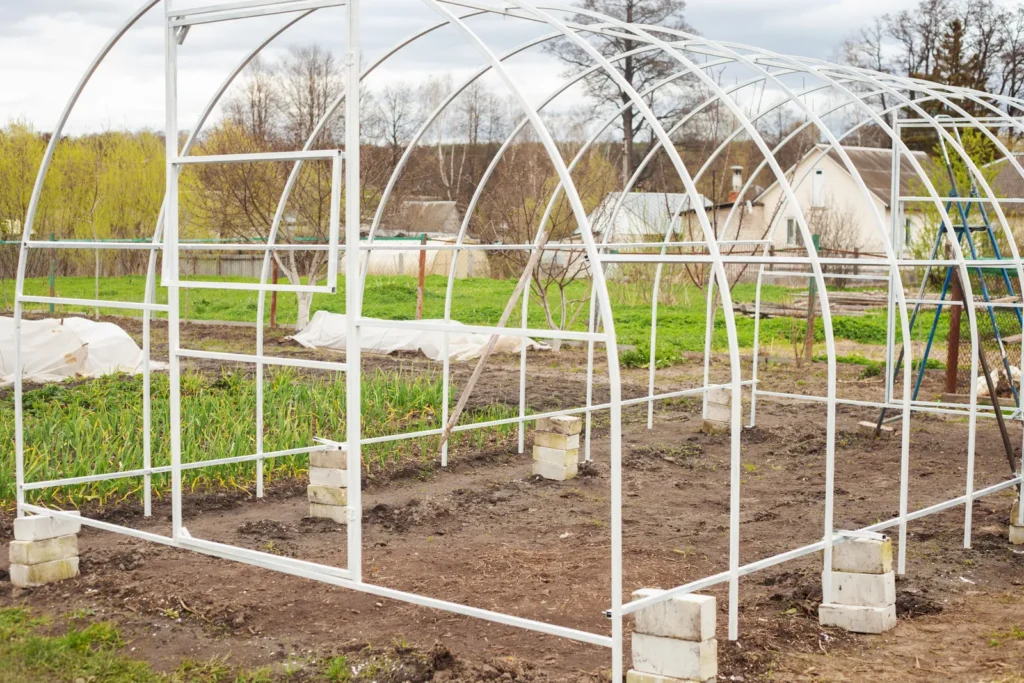Select a location for your greenhouse that gets at least six hours of direct sunlight per day while making your plans. Make sure the location is protected from severe winds and has adequate drainage. The normal size for home gardeners is 10 by 12 feet; however, you should determine the size based on your growing needs and available area.
Choose the kind of greenhouse you want—a lean-to, freestanding, or hoop house, for example—and the materials you want to use for the covering and frame. For the frame, common materials include wood, PVC, or metal; for the covering, common materials include polyethylene film, polycarbonate panels, or glass.
You will be guided step-by-step through the process of building an effective and practical greenhouse by this tutorial. The main steps for making one are as follows.
Getting Supplies and Equipment Together
Before you begin, gather the supplies and equipment needed for your greenhouse project. Materials for the frame (wood, PVC, or metal), covering (polyethylene film, polycarbonate panels, or glass), and foundation (concrete blocks, treated lumber, or gravel) are required. You’ll also need optional doors and windows, brackets, screws, and nails. A level, a hammer or drill, a saw (if working with metal or wood), a tape measure, and a shovel for the foundation are all necessary instruments.
Establishing the Base
A strong base is essential to your greenhouse’s stability. A concrete block foundation is one alternative. To set the blocks in the trench and make sure they are level and aligned, first outline the perimeter with pegs and twine.
A treated lumber foundation is an additional option in which the perimeter is marked, a shallow trench is dug, treated timber is laid in the trench to form the base frame, and metal brackets are used to secure the corners. As an alternative, you can use a gravel foundation, which involves leveling the surface by filling the space with gravel, defining the perimeter, and removing the top layer of soil.
Building the Structure
Cutting the materials to the correct lengths for the base, sides, and roof is the first step in building the greenhouse’s frame. When building a wood frame, you must cut the wood, put the base frame together, and fasten it to the foundation. The side walls should then be built and fastened to the base structure.
Lastly, the roof frame should be built and fastened to the side walls. To assemble a PVC frame, cut the PVC pipes to the necessary lengths, build the side walls, attach them to the base frame, and assemble the base frame using PVC connectors. Construct the roof structure and fasten it to the adjacent walls. To ensure a stable structure, make sure all the parts are firmly secured.
Putting the Covering in Place
A crucial first step in safeguarding your plants and establishing the perfect growing environment is installing the covering on your greenhouse. If you’re using polyethylene film, wrap it around the frame and fasten it firmly with staples or clips.
Measure and cut polycarbonate panels to fit the frame, then fasten them using screws or clips. If glass is being used, measure and cut the glass panes carefully, then use glazing clips or putty to attach them to the frame. To keep the interior temperature constant and avoid drafts, make sure the covering is well fastened.
Including Doors and Vents
In order to control the humidity and temperature inside your greenhouse, proper ventilation is necessary. To promote air circulation, install windows or vents in the greenhouse’s sides and roof. Installing automatic vent openers will allow the vents to open and close in response to changes in interior temperature.
Including a door makes entering your greenhouse simple. Install a door with hinges and a latch to ensure it fits the frame securely. To keep the interior temperature stable and avoid drafts, think about installing weather stripping around the door.
Organizing the Interior
Shelves, seats, and planting beds must be arranged inside your greenhouse to maximize available space and ease of access. For shelving and benches, use materials that are strong enough to hold the weight of trays and pots. Organize the benches and shelves to make it simple to move about and get to every plant.
If planting beds are being used, make sure to fill them with compost and premium soil. To make sure your plants get enough water, think about installing a watering system, like drip irrigation or a hose with a spray nozzle. Plants should be arranged according to their requirements for temperature and light; place shorter plants in front and taller plants in the back for the most exposure to sunlight.
Summary
Constructing a personal greenhouse is a rewarding endeavor that grants you authority over your gardening surroundings, prolongs your planting season, and enables you to grow an assortment of plants throughout the year.
You may build a productive and effective greenhouse by carefully planning it, assembling the required supplies and equipment, building a sturdy base and frame, installing the right covering, and thoughtfully organizing the interior. The health and quantity of your plants will show the advantages of owning your own greenhouse, regardless of the size and style you select—small and straightforward or larger and more intricate. Cheers to your successful gardening!

